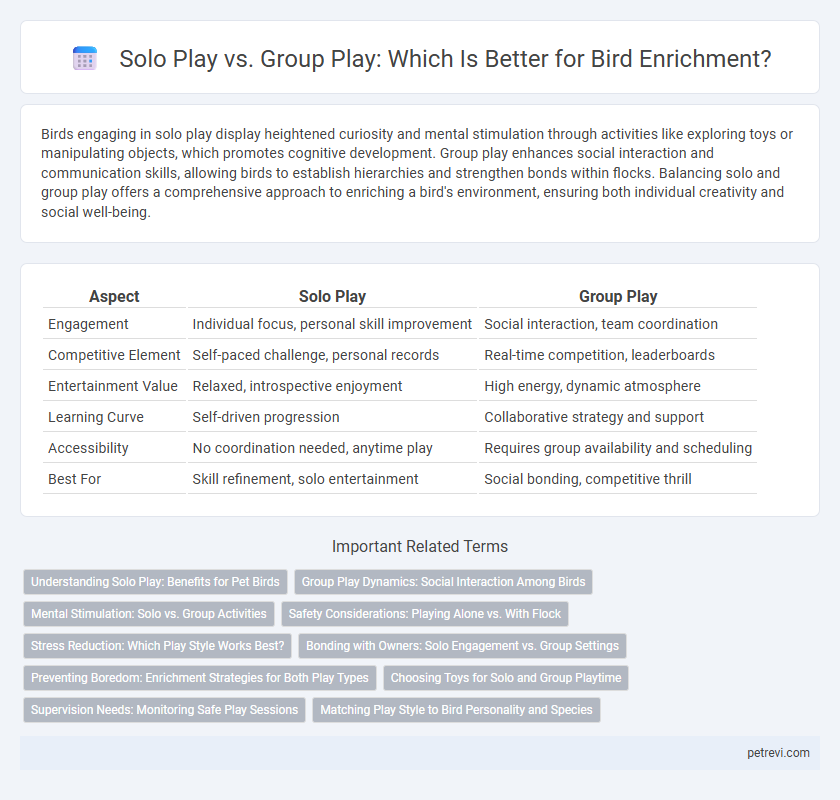Birds engaging in solo play display heightened curiosity and mental stimulation through activities like exploring toys or manipulating objects, which promotes cognitive development. Group play enhances social interaction and communication skills, allowing birds to establish hierarchies and strengthen bonds within flocks. Balancing solo and group play offers a comprehensive approach to enriching a bird's environment, ensuring both individual creativity and social well-being.
Table of Comparison
| Aspect | Solo Play | Group Play |
|---|---|---|
| Engagement | Individual focus, personal skill improvement | Social interaction, team coordination |
| Competitive Element | Self-paced challenge, personal records | Real-time competition, leaderboards |
| Entertainment Value | Relaxed, introspective enjoyment | High energy, dynamic atmosphere |
| Learning Curve | Self-driven progression | Collaborative strategy and support |
| Accessibility | No coordination needed, anytime play | Requires group availability and scheduling |
| Best For | Skill refinement, solo entertainment | Social bonding, competitive thrill |
Understanding Solo Play: Benefits for Pet Birds
Solo play offers pet birds mental stimulation and prevents boredom by encouraging independent exploration of toys and activities. It helps strengthen a bird's problem-solving skills and fosters self-confidence, essential for overall well-being. Creating a variety of engaging solo play opportunities reduces stress and supports healthy behavioral development in pet birds.
Group Play Dynamics: Social Interaction Among Birds
Group play fosters complex social interactions among birds, enhancing communication skills and strengthening flock cohesion through synchronized movements and vocalizations. These dynamics encourage cooperative behaviors such as collective foraging and predator vigilance, promoting survival advantages. Social play within groups also supports cognitive development by challenging birds to interpret and respond to varied social cues effectively.
Mental Stimulation: Solo vs. Group Activities
Solo play for birds offers focused mental stimulation by encouraging problem-solving through individual toys and puzzles, enhancing cognitive skills without distractions. Group play promotes social interaction, which boosts emotional wellbeing and mental engagement through activities like cooperative foraging and vocal communication. Balancing solo and group activities optimizes overall mental health and enriches behavioral complexity in avian entertainment.
Safety Considerations: Playing Alone vs. With Flock
Solo play for birds reduces the risk of injury from aggressive flockmates and allows for closer monitoring of health issues, but it may increase stress due to isolation. Group play provides social stimulation and natural interaction beneficial for mental well-being, though it requires careful supervision to prevent territorial disputes or pecking order conflicts. Ensuring a safe environment involves balancing social needs with individual temperament to minimize harm during play sessions.
Stress Reduction: Which Play Style Works Best?
Solo play in birds often provides a calming effect, allowing them to engage in self-stimulating activities like foraging or preening that reduce stress independently. Group play encourages social interaction, which boosts mental stimulation and can alleviate anxiety through companionship and cooperative behaviors. The best play style for stress reduction varies by species and individual temperament, with some birds thriving in solitary engagement while others benefit more from social play dynamics.
Bonding with Owners: Solo Engagement vs. Group Settings
Birds exhibit distinct bonding behaviors during solo play compared to group settings, with solo engagement fostering stronger, more personalized connections between birds and their owners. Solo play allows birds to focus entirely on interactive toys, vocalizations, and hand-feeding, enhancing trust and communication. In contrast, group play stimulates natural social dynamics yet may dilute individual attention, affecting the intensity of the bond with a single owner.
Preventing Boredom: Enrichment Strategies for Both Play Types
Solo play for birds includes foraging toys and puzzle feeders that stimulate natural behaviors and prevent boredom by engaging their problem-solving skills. Group play offers social interaction through interactive play sessions and communal activities that promote mental stimulation and reduce stress. Incorporating a variety of enrichment strategies tailored to both solo and group environments ensures birds remain mentally and physically active, enhancing overall well-being.
Choosing Toys for Solo and Group Playtime
Selecting toys for bird entertainment depends on whether the playtime is solo or in a group setting. Solo play toys should focus on mental stimulation and physical activity, such as foraging puzzles and chewable toys that encourage independent exploration and prevent boredom. For group play, interactive and larger toys like swings or climbing structures promote social interaction, cooperation, and collective exercise among birds.
Supervision Needs: Monitoring Safe Play Sessions
Solo play allows birds to entertain themselves independently, reducing the need for constant supervision but requiring safe, bird-proofed environments to prevent accidents. Group play offers social interaction and mental stimulation but demands closer monitoring to manage potential conflicts and ensure harmonious behavior. Careful supervision during group sessions helps prevent injuries and promotes positive social dynamics among birds.
Matching Play Style to Bird Personality and Species
Birds exhibit diverse play behaviors that align closely with their species-specific traits and individual personalities, making the choice between solo play and group play crucial for their well-being. Solitary species like certain parrots and finches thrive with independent toys that stimulate problem-solving, while highly social birds such as cockatoos and budgerigars benefit from interactive group play that fosters mental engagement and social bonding. Tailoring play activities to the bird's natural social structure and temperament enhances enrichment, reduces stress, and promotes overall health.
Solo play vs Group play for Bird entertainment Infographic

 petrevi.com
petrevi.com